The Intel NUC8i7HVK (Hades Canyon) Review: Kaby Lake-G Benchmarked
by Ganesh T S on March 29, 2018 1:00 PM ESTPerformance Metrics - I
The Intel NUC8i7HVK (Hades Canyon) was evaluated using our standard test suite for small form-factor gaming PCs. Not all benchmarks were processed on all the machines due to updates in our testing procedures. Therefore, the list of PCs in each graph might not be the same. In the first section, we will be looking at SYSmark 2014 SE, as well as some of the Futuremark benchmarks.
BAPCo SYSmark 2014 SE
BAPCo's SYSmark 2014 SE is an application-based benchmark that uses real-world applications to replay usage patterns of business users in the areas of office productivity, media creation and data/financial analysis. In addition, it also addresses the responsiveness aspect which deals with user experience as related to application and file launches, multi-tasking etc. Scores are meant to be compared against a reference desktop (the SYSmark 2014 SE calibration system in the graphs below). While the SYSmark 2014 benchmark used a Haswell-based desktop configuration, the SYSmark 2014 SE makes the move to a Lenovo ThinkCenter M800 (Intel Core i3-6100, 4GB RAM and a 256GB SATA SSD). The calibration system scores 1000 in each of the scenarios. A score of, say, 2000, would imply that the system under test is twice as fast as the reference system.

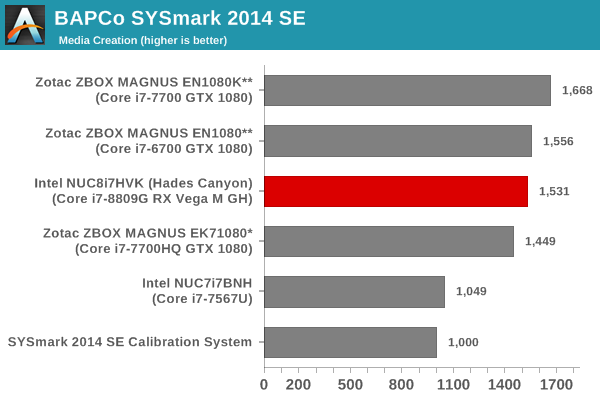

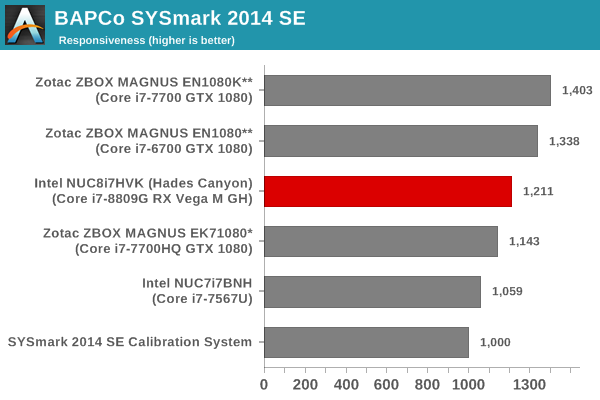
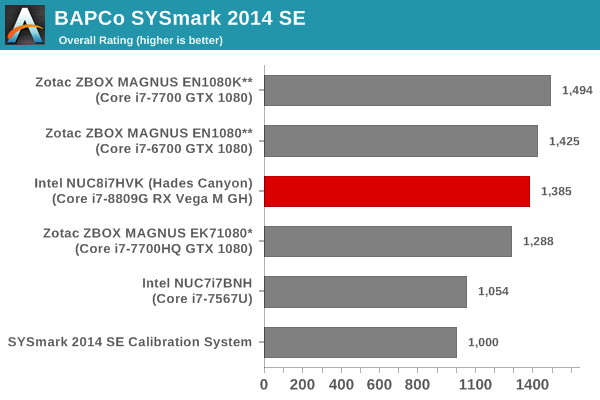
SYSmark 2014 SE also adds energy measurement to the mix. A high score in the SYSmark benchmarks might be nice to have, but, potential customers also need to determine the balance between power consumption and the efficiency of the system. For example, in the average office scenario, it might not be worth purchasing a noisy and power-hungry PC just because it ends up with a 2000 score in the SYSmark 2014 SE benchmarks. In order to provide a balanced perspective, SYSmark 2014 SE also allows vendors and decision makers to track the energy consumption during each workload. In the graphs below, we find the total energy consumed by the PC under test for a single iteration of each SYSmark 2014 SE workload and how it compares against the calibration systems.
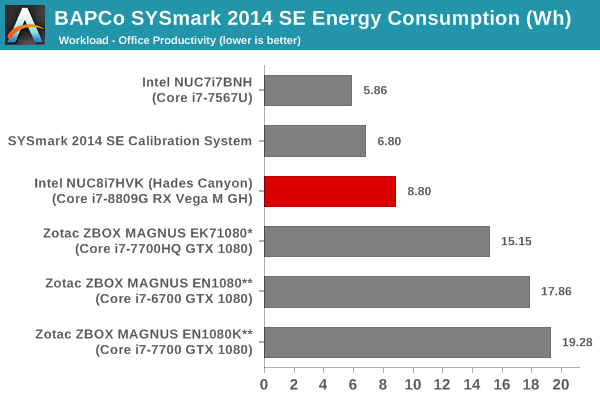
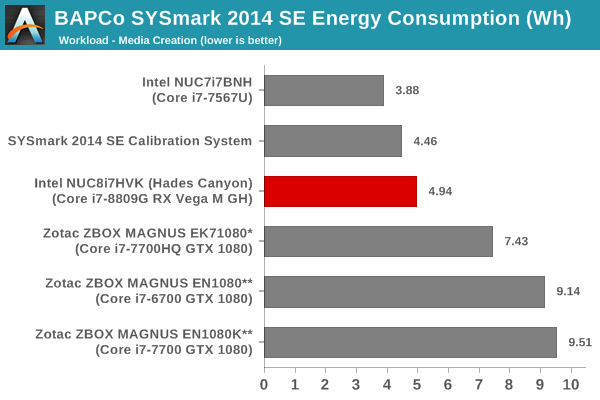
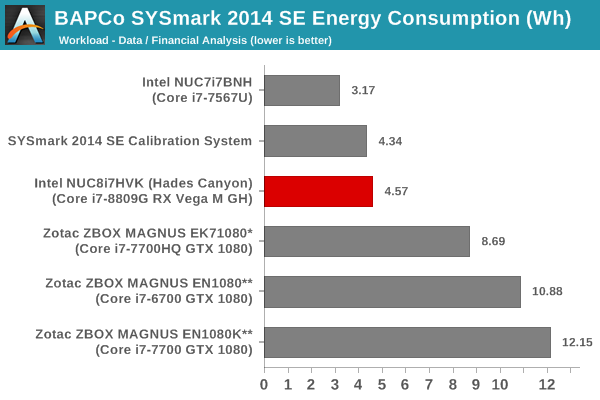

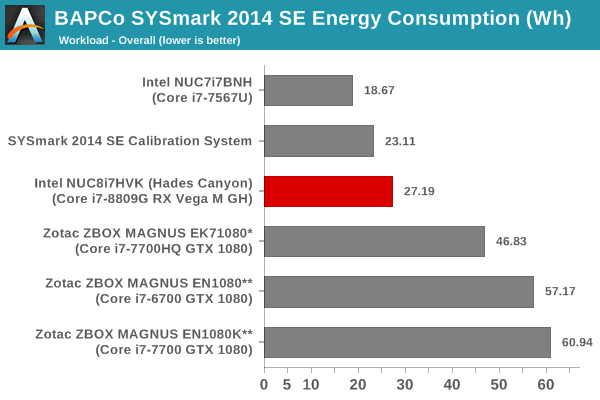
Despite being fully patched for Meltdown and Spectre, the Core i7-8809G manages to outscore the partially patched Core i7-7700HQ-based ZBOX MAGNUS EK71080. It is beat in terms of raw score by the ZBOX MAGNUS PCs using the desktop CPUs (Core i7-6700 and Core i7-7700), but, those PCs consume much more energy to complete the workloads.
Futuremark PCMark 10
UL's PCMark 10 evaluates computing systems for various usage scenarios (generic / essential tasks such as web browsing and starting up applications, productivity tasks such as editing spreadsheets and documents, gaming, and digital content creation). We benchmarked select PCs with the PCMark 10 Extended profile and recorded the scores for various scenarios. These scores are heavily influenced by the CPU and GPU in the system, though the RAM and storage device also play a part. The power plan was set to Balanced for all the PCs while processing the PCMark 10 benchmark.





Futuremark PCMark 8
We continue to present PCMark 8 benchmark results (as those have more comparison points) while our PCMark 10 scores database for systems grows in size. PCMark 8 provides various usage scenarios (home, creative and work) and offers ways to benchmark both baseline (CPU-only) as well as OpenCL accelerated (CPU + GPU) performance. We benchmarked select PCs for the OpenCL accelerated performance in all three usage scenarios. These scores are heavily influenced by the CPU in the system. The results should be analyzed while keeping in mind that most of the comparison systems have scores from the days prior to the release of the Meltdown and Spectre patches.



Miscellaneous Futuremark Benchmarks





3D Rendering - CINEBENCH R15
We have moved on from R11.5 to R15 for 3D rendering evaluation. CINEBENCH R15 provides three benchmark modes - OpenGL, single threaded and multi-threaded. Evaluation of select PCs in all three modes provided us the following results. Here, we see the benefits of running the CPU die with a 65W TDP. The scores match or beat the results from the Core i7-7700 in the ZBOX MAGNUS EN1080K.













124 Comments
View All Comments
PeachNCream - Friday, March 30, 2018 - link
The price really is way too high right now compared to a laptop if your focus is gaming. If you need a LAN party portable box, a laptop is usually a better option anyway since the screen and keyboard aren't additional components you'll have to take with you. Because the NUC is so small, it lacks the upgrade advantages offered by a desktop form factor so you're basically dealing with an overpriced, screenless laptop. I'm all for the technology at the heart of the new NUC, but you're absolutely right that it needs to start at $600.bill44 - Thursday, March 29, 2018 - link
I was hoping so much from this machine, ready to buy, only to be disappointed.No Titan Ridge TB3 (DP 1.4)
No UHD-BD playback
TB3 not connected to CPU
UHS-1 only card reader, no UHS-II
Issues with storage bandwidth since Spectre/Meltdown issues, no in-silicon fix (I know, 2nd half 2018).
Disappointing WiFi speed, no BT 5, even if M.2 changed no aerial.
Hardware decoding/codec issues
etc.
When can we expect the next (fixed version) :)
cacnoff - Thursday, March 29, 2018 - link
Titan Ridge - not out yet.UHD-BD playback - doesn't work on nvidia either.
Point to ANY designs with TB3 connected to CPU.
repoman27 - Thursday, March 29, 2018 - link
Apple does this pretty regularly. But last I knew, everyone else had to go through the PCH due to Windows / UEFI limitations. Which is a bummer because of the additional latency and clear potential for bandwidth contention.Hifihedgehog - Thursday, March 29, 2018 - link
“We can actually see that the codec support from the Intel side is miles ahead of the Radeon's capabilities.”This is misinformed at best, and categorically false at worse. I have been using a Ryzen 5 2400G, on an ASRock AB350 Gaming-ITX/ac motherboard to drive an HDMI 2.0 4K display at 12-bit (yes, despite lacking formal certification, HDMI 2.0 works flawlessly on 300-series motherboards). I successfully can play back various hefty video material, including HEVC in the form of lossless MKV rips of my UHD Blu-rays, and VP9. Moreover, the color, deblocking, and scaling is far superior in terms of pure optical fidelity to the Intel Skull Canyon NUC’s hazy, unrefined hardware decoding solution. Also, I could go at length about the dropout and timing issues of Intel’s HD Graphics with various high-end AV receivers (Marantz, Denon, and Yamaha) that I have had (e.g. timing issues from their onboard DP-to-HDMI converters causing DAC and sound processing to operate in a compatibility mode with 16-bit sound depth). Suffice it to say, from an objective standpoint, Intel’s NUCs are utter trash, littered with issues, that fall far short from being serious home theater solutions.
garbagedisposal - Thursday, March 29, 2018 - link
" misinformed at best, and categorically false at worse"Yes, you are.
"HDMI 2.0 works flawlessly on 300-series motherboards"
Congrats on discovering the obvious. Nobody claimed otherwise
"successfully can play back various hefty video material, including HEVC"
So can intel, better and at lower power. Isn't it sad that the radeon can't do VP9 or netflix?
"color, deblocking, and scaling is far superior"
Sure. Everything just looks so wrong on intel. Certainly takes a special snowflake like you to notice, good job.
"Marantz, Denon, and Yamaha"
Nobody cares.
Rabid angry people like you are funny, do you really think anyone is going to read or care about your comment? Go away LOL
Hifihedgehog - Thursday, March 29, 2018 - link
Please be polite and less “rabid.” Thanks.Hifihedgehog - Thursday, March 29, 2018 - link
For anyone reading the post above, Vega can correctly decode VP9, hybrid or otherwise. What was posted above is incorrect.Hifihedgehog - Thursday, March 29, 2018 - link
“Congrats on discovering the obvious. Nobody claimed otherwise”This is also false. Many reviews online of the Ryzen Raven Ridge APUs claimed that HDMI 2.0 support was yet non-existent given that most motherboard manufacturers state only HDMI 1.4 for their 300-series AM4 boards. This concerned many users, but after thorough research and testing (see here: smallformfactor (dot) net /forum/threads/raven-ridge-hdmi-2-0-compatibility-1st-gen-am4-motherboard-test-request-megathread.6709/ ; I am the one who started the thread and led its discussion), it was concluded that all current motherboards work without limitations or issue regardless of the published specifications. I will also ignore the passive-aggressive sarcasm and sentiment laced in-between the lines from the “Congrats” to the “LOL.” Please be less rabid and angry, and more people will take your seriously.
ganeshts - Thursday, March 29, 2018 - link
The Radeon GPU CAN NOT do VP9 Profile 2 - so you will NEVER get YouTube HDR on the. No PAVP. QuickSync ecosystem support is way ahead of Radeon VCE. So, tell me why I am wrong in saying that the Intel iGPU is miles ahead of the Radeon Vega ? Any neutral industry observer can see that I am completely justified in making those claims.I am not talking about Ryzen APUs - I am talking about the Radeon GPU in the Core i7-8809G, as utilized in the NUC8i7HVK.